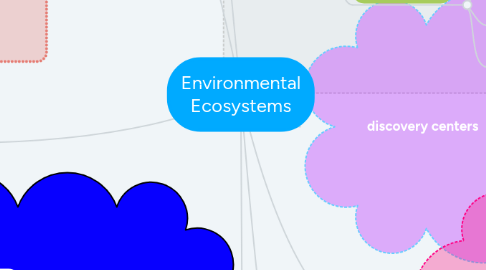
1. assessments
1.1. The chapter assessments will be formatted with multiple choice questions, fill in the blank, and short answer.
1.2. chapter assessment
1.2.1. people: How it impacts the environment.
1.2.2. Animal Habitat: Students create their own food chain and describe each animal to be a herbivore, carnivore, or predator.
1.2.3. Types of Ecosystems: Students will identify the different ecosystems that are in our world and how that effects the animals that live within it.
1.3. Quzzes
1.3.1. Quizzes: There will be quizzes for each portion of a lesson that is taught within the unit. There will be ten multiple choice questions for each quiz.
1.4. project
1.4.1. build your own environment: Have the students research a place with the type of environment of their choice, and replicate it. (include animals, living/nonliving things, etc)
1.4.2. Students will invent their own product constructed out of old/used material in order to practice reusing and recycling in an active way. They will be required to pitch their idea with the class.
2. technology integration
2.1. students work on computers with pixie format
2.2. iPads:Students can work on an iPad to do activities on an app that pertain to food chains and the ecosystem.
2.3. Powerpoints will be utilized in the classroom to teach lessons.
2.4. Children videos: Crash Course food chains video. A video about learning about pollution.
3. Unit Library
3.1. Day 1
3.1.1. The ABC's of Habitats by Bobbie Kalman
3.1.2. Oh Why Are Deserts Dry by Tish Rabe
3.1.3. If I Ran The Rain forest by Bonnie Worth
3.2. Day 2
3.2.1. If I Ran The Rain forest by Bonnie Worth
3.2.2. Day and Night in the Rain Forest by Dana Townsend
3.2.3. What are food chains and webs by Bobbie Kalman and Jacqueline Langile
3.3. Day 3
3.3.1. Is It a Living Thing? Introducing Living Things by Bobbie Kalman
3.3.2. I Know It Is Nonliving by Sheila Rivera
3.3.3. What Do Living Things Need by Elizabeth Austen
3.4. Day 4
3.4.1. The Lorax by Dr. Suess
3.4.2. Did Your Can of Soda Kill A Whale? Water Pollution for Kids | Children's Environment Books by Baby Professor
3.4.3. Air Pollution! How to Limit the Pollution of the Air by Baby IQ Builder Books
3.4.4. Pollution : Problems Made by Man by Baby Professor
3.5. Day 5
3.5.1. One Plastic Bag by Miranda Paul
3.5.2. Not for Me, Please! I Choose to Act Green by Maria Godsey
3.5.3. Why Should I Recycle? by Jen Green
3.5.4. 10 Things I Can Do to Help My World by Melanie Walsh
3.6. Day 6
3.6.1. Tree Lady by H. Joseph Hopkins
3.6.2. Don't Throw That Away! A Lift-the-Flap Book about Recycling and Reusing by Lara Bergen
3.6.3. My Forever Dress by Harriet Ziefert
3.6.4. OK Go by Carin Berger
4. Lessons
4.1. People
4.1.1. Day 6
4.1.1.1. Eco-Friendly Thinking; How can we invent new ways to help our environment?
4.1.1.1.1. Encourage students to use their knowledge of reusing and recycling to think of new ways of keeping pollution and litter out of our environment
4.1.2. Day 5
4.1.2.1. Cleaning Up Our Act; learning about recycling and why it important
4.1.2.1.1. Students will analyze their bad habits regarding the environment and ways we can eliminate them (reduce, reuse, recycle)
4.1.3. Day 4
4.1.3.1. Our Effect on the Environment; what bad habits do we have that hurt nature
4.1.3.1.1. Pollution, deforestation, over hunting; taking a larger look at pollution, what it is why its harmful, and how to fix the problem.
4.2. Animals Habitat
4.2.1. food chain
4.2.1.1. Herbivore
4.2.1.2. Carnivore
4.2.1.3. Predator
4.3. Types of Ecosystems
4.3.1. Grasslands
4.3.1.1. What animals live there? Living/nonliving things?
4.3.2. Deserts
4.3.2.1. What animals live there? Living/nonliving things?
4.3.3. Marine
4.3.3.1. What animals live there? Living/nonliving things
4.3.4. Forrest
4.3.4.1. What animals live there? Living/nonliving things
5. activities
5.1. people
5.1.1. creating a picture log of one bad thing we do to the environment and one way to fix that problem.
5.1.2. Students can have a debate with one another on how we can fix the environment from pollution and ways we can potentially solve the problem.
5.2. animals habitat
5.2.1. taking care of fish in a fish tank and logging their daily routine.
5.2.2. Watching a butterfly grow from a catipllar and into a butterfly. Students will create a log chart and once the butterflies are fully grown, we will release them outside.
5.3. Types of Ecosystems
5.3.1. Guess the ecosystem game (can either work in groups against the class or with a partner at their desk) will be given hints of the type of ecosystem and must hold up a picture of it to answer.
5.3.2. create your own ecosystem with fish and insects using a liter bottle.

